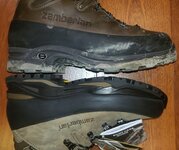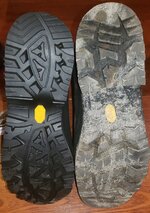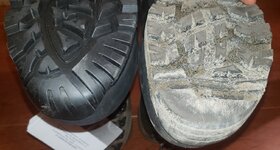I have some preliminary observations from my comparison of the Zamberlan Hunter Pro Evo GTX and Sawtooth insulated boots that might be useful to others as the differences between the boots are not clearly stated online. I should add the caveat that I'm comparing size US 8.5/42 Sawtooth to a size US 9/43 Hunter pro, so I'll try to normalize my comparisons as best as possible. I have a suspicion that the Sawtooth runs small and the Hunter Pro runs large based on my comparison with my size US 9/42 (wide fit) Lowa Tibet GTX boots which fall right in the middle. I have very wide feet and compared all boots using Superfeet green insoles, thin merino liner socks, and medium volume outer hiking socks.
Out of the box, my first impression is that both boots are well-crafted and constructed of premium materials, with BEEFY rubber rands for scuff protection. A squeeze test suggests that both boots have similar thickness insulation and the weight is fairly comparable between the two boots (size taken into account). My additional observations are as follows:
Sawtooth: Sole width and edges taper towards the toe and the toe has substantial rocker. Lateral stability decreases when rolling this boot forwards onto tippy-toe, but I think this would be a more "nimble" toe for scrambling up hills and rock (i.e., goat/sheep hunting terrain). The sole has little to no perceptible flex underfoot or flexed by hand, yet a natural stride is possible due to the rocker- a very easy walking boot. Sole is standard Vibram "hard-feeling" density and should be long-wearing. Sawtooth upper is made of a relatively soft leather and padding, so ankle support is "medium," similar to my Lowa Tibet 8" tall boots. The forefoot/toe of the boot is constructed from one folded piece of leather, meaning no stiches in the front of the boot (potential leak points). Overall, a nimble and stiff mountain boot that may be preferred by mountain hunters with wide feet.
Hunter Pro GTX: Sole is very flat all the way to the toe with no rounded edges like the Sawtooth. There is some flex under the ball of the foot and light rocker, making this an easy walking boot with lots of lateral support when on tippy-toe. Toe box may be wider at the very tip than on the Sawtooth due to the rounder toe profile. The sole is made of slightly softer vibram rubber than on the Sawtooth or Tibets- perhaps a better durometer for cold conditions, but potentially quick-wearing on rocks. Upper leather is stiff, waxed leather and is more supportive laterally than the Sawtooth (or my Lowa Tibets). Overall, this may be a better boot for those who walk flatter terrain and prefer more ankle support. I also like the smooth leather which I think will be easier to keep waterproofed. Overall, a good backpacking boot for all hunting conditions with a slightly less nimble feel than the Sawtooth, but more support lateral and potentially toe space. I have worn these boots for about 15 hours doing yardwork and short hikes and so far they are quite comfortable, though my foot fatigues after about 2 miles with an 80 lb pack, likely because I'm used my very stiff Tibets.
I went with the Hunter Pros based on fit, but I think I'd have been equally happy in the Sawtooths. I hope to put some serious miles in variable Alaska fall conditions in my Hunter Pros this week.
Out of the box, my first impression is that both boots are well-crafted and constructed of premium materials, with BEEFY rubber rands for scuff protection. A squeeze test suggests that both boots have similar thickness insulation and the weight is fairly comparable between the two boots (size taken into account). My additional observations are as follows:
Sawtooth: Sole width and edges taper towards the toe and the toe has substantial rocker. Lateral stability decreases when rolling this boot forwards onto tippy-toe, but I think this would be a more "nimble" toe for scrambling up hills and rock (i.e., goat/sheep hunting terrain). The sole has little to no perceptible flex underfoot or flexed by hand, yet a natural stride is possible due to the rocker- a very easy walking boot. Sole is standard Vibram "hard-feeling" density and should be long-wearing. Sawtooth upper is made of a relatively soft leather and padding, so ankle support is "medium," similar to my Lowa Tibet 8" tall boots. The forefoot/toe of the boot is constructed from one folded piece of leather, meaning no stiches in the front of the boot (potential leak points). Overall, a nimble and stiff mountain boot that may be preferred by mountain hunters with wide feet.
Hunter Pro GTX: Sole is very flat all the way to the toe with no rounded edges like the Sawtooth. There is some flex under the ball of the foot and light rocker, making this an easy walking boot with lots of lateral support when on tippy-toe. Toe box may be wider at the very tip than on the Sawtooth due to the rounder toe profile. The sole is made of slightly softer vibram rubber than on the Sawtooth or Tibets- perhaps a better durometer for cold conditions, but potentially quick-wearing on rocks. Upper leather is stiff, waxed leather and is more supportive laterally than the Sawtooth (or my Lowa Tibets). Overall, this may be a better boot for those who walk flatter terrain and prefer more ankle support. I also like the smooth leather which I think will be easier to keep waterproofed. Overall, a good backpacking boot for all hunting conditions with a slightly less nimble feel than the Sawtooth, but more support lateral and potentially toe space. I have worn these boots for about 15 hours doing yardwork and short hikes and so far they are quite comfortable, though my foot fatigues after about 2 miles with an 80 lb pack, likely because I'm used my very stiff Tibets.
I went with the Hunter Pros based on fit, but I think I'd have been equally happy in the Sawtooths. I hope to put some serious miles in variable Alaska fall conditions in my Hunter Pros this week.
Attachments
Last edited:




